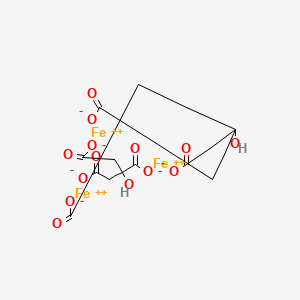



1. Citric Acid, Iron(2+) Salt
2. Fe(ii) Citrate
3. Fenelmin
4. Fenilene
5. Feredaim
6. Ferromia
7. Ferrostec
8. Ferrous Citrate
9. Ferrous Citrate Fe 58
10. Ferrous Citrate Fe 59
11. Ferrous Citrate Fe-58
12. Ferrous Citrate Fe-59
13. Ferrous-58 Citrate
14. Ferrous-59 Citrate
15. Ferrutope
16. Iromia
17. Monoferrous Acid Citrate
18. Sodium Ferrous Citrate
19. Tetrasodium Ferrous Dicitrate
1. 23383-11-1
| Molecular Weight | 545.73 g/mol |
|---|---|
| Molecular Formula | C12H10Fe3O14 |
| Hydrogen Bond Donor Count | 2 |
| Hydrogen Bond Acceptor Count | 14 |
| Rotatable Bond Count | 4 |
| Exact Mass | 545.811862 g/mol |
| Monoisotopic Mass | 545.811862 g/mol |
| Topological Polar Surface Area | 281 Ų |
| Heavy Atom Count | 29 |
| Formal Charge | 0 |
| Complexity | 211 |
| Isotope Atom Count | 0 |
| Defined Atom Stereocenter Count | 0 |
| Undefined Atom Stereocenter Count | 0 |
| Defined Bond Stereocenter Count | 0 |
| Undefined Bond Stereocenter Count | 0 |
| Covalently Bonded Unit Count | 5 |
Hematinic
O'Neil, M.J. (ed.). The Merck Index - An Encyclopedia of Chemicals, Drugs, and Biologicals. 13th Edition, Whitehouse Station, NJ: Merck and Co., Inc., 2001., p. 716
The in vitro and in vivo availability of iron from total parenteral nutrition solutions to which ferrous citrate has been added was investigated. In vitro experiments showed that 74% of the added iron was available to transferrin. In 7 patients in whom in vivo availability was tested by red cell incorporation, the mean availability was 81%. It was concluded that ferrous citrate is a safe and effective means of iron supplementation in patients on TPN therapy.
Sayers MH et al. JPEN J Parenter Enteral Nutr 7 (2): 117-20 (1983)
Trace Elements
A group of chemical elements that are needed in minute quantities for the proper growth, development, and physiology of an organism. (From McGraw-Hill Dictionary of Scientific and Technical Terms, 4th ed) (See all compounds classified as Trace Elements.)
Gastrointestinal absorption of iron is adequate ... /yet/ ... lower from ferrous citrate ... /than ferrous sulfate, fumarate, gluconate, succinate, glutamate, and lactate/.
Goodman, L.S., and A. Gilman. (eds.) The Pharmacological Basis of Therapeutics. 5th ed. New York: Macmillan Publishing Co., Inc., 1975., p. 1315
This study demonstrated that anticholinergic agents decreased iron absorption in man and animals. Six normal males were given 10 Ci of 59Fe ferrous citrate dissolved in water containing 250 mg of ferrous sulfate after an overnight fast. Whole body counts were done 4 hours later and used as baseline studies. Sixty minutes before the administration of radioiron, the subjects received a dose of 62.5 mg of hexocyclium methosulfate (Tral). The dose was repeated 6 hours later. Four hours after ingestion of radioiron, whole body counting was done. Every 5 days thereafter, for 15 days, a plateau of body radioactivity was reached in all subjects. Percentage absorption was calculated from the final to initial counts, after correction. Similar experiments were done in rats with atropine sulfate. In both experiments, the anticholinergic agent produced a decrease in iron absorption. The effect of atropine persisted when the iron was delivered intragastrically, but not intraduodenally. Another set of experiments showed that iron absorption decreases when radioiron is intraduodenally given in deproteinized acid gastric juice, or in 0.1N HCl, but not when mixed with neutralized gastric juice.
Orrego-Matte H et al; Am J Dige Dis 16 (9): 789-795 (1971)
The uptake of ferrous citrate 59Fe was studied in pregnant rats with or without a 4-dimethylamino-stilben(DS)-induced sarcoma tumor. ... The embryo showed higher concentrations of 59Fe. ... Iron loading only affected the embryo liver. Tumors and the placenta showed a different incorporation of 59Fe.
PMID:3857177 Anghileri LJ et al; Eur J Nucl Med 10 (5-6): 288-9 (1985)